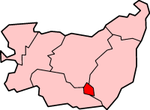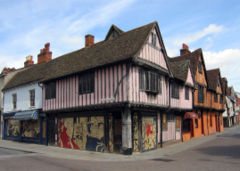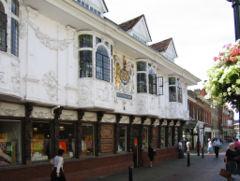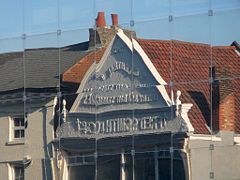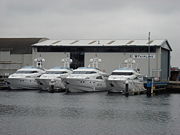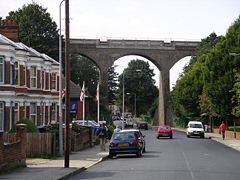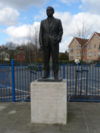Ipswich
2008/9 Schools Wikipedia Selection. Related subjects: British Cities; Great Britain
| Ipswich | |
| — Town — | |
| Borough of Ipswich | |
| Motto: King, Commons, Lords | |
|
Shown within Suffolk |
|
| Sovereign state | United Kingdom |
|---|---|
| Constituent Country | England |
| Region | East of England |
| County | Suffolk |
| Borough | Ipswich |
| Government Leadership:Leader & Cabinet | |
| - Type | Ipswich Borough Council |
| - MPs | Michael Lord, Chris Mole |
| Area - Ranked 320th | |
| - Borough | 15.2 sq mi (39.42 km²) |
| Population | |
| - Borough | Ranked 164th 120,400 |
| - Density | 7,909.8/sq mi (3,054/km²) |
| - Urban | 138,718 |
| - Ethnicity | 90.5% White 2.1% Black 3.9% S.Asian 1.1% Chinese or Other 2.4% Mixed RaceUNIQ167a685,612b44,469-ref-00,000,000-QINU |
| ONS code | 42UD |
Ipswich ( pronunciation ; IPA: /ˈɪpswɪtʃ/) is a non-metropolitan district in and the county town of Suffolk, England on the estuary of the River Orwell. The town of the same name overspills the borough boundaries significantly, with only 85% of the town's population living within the borough at the time of the 2001 Census, when it was the third-largest settlement in the United Kingdom's East of England region, and the 38th largest urban area in England.
As of 2006, the borough is estimated to have a population of approximately 120,000 inhabitants.
History
The Eemian interglacial is known as the Ipswichian period in geology and occurred about 120,000 years ago.
Under the Roman empire, the area around Ipswich formed an important route inland to rural towns and settlements via the Orwell and Gipping. A large Roman fort, part of the coast defences of Britain, stood at Felixstowe (13 miles, 21 km), and the largest villa in Suffolk stood at Castle Hill (north-west Ipswich).
Ipswich is one of England's oldest towns, and took shape in Anglo-Saxon times as the main centre between York and London for North Sea trade to Scandinavia and the Rhine. It served the Kingdom of East Anglia, and began developing in the time of King Rædwald, supreme ruler of the English (616-624). The famous ship-burial and treasure at Sutton Hoo nearby (9 miles, 14.5 km) is probably his grave. The Ipswich Museum houses replicas of the Roman Mildenhall Treasure and the Sutton Hoo treasure. A gallery devoted to the town's origins includes Anglo-Saxon weapons, jewellery and other artefacts.
The seventh-century town, called 'Gippeswick' was centred near the quay. Towards 700 AD, Frisian potters from the Netherlands area settled in Ipswich and set up the first large-scale potteries in England since Roman times. Their wares were traded far across England, and the industry was unique to Ipswich for 200 years. With growing prosperity, in about 720 AD a large new part of the town was laid out in the Buttermarket area. Ipswich was becoming a place of national and international importance. Parts of the ancient road plan still survive in its modern streets. After the invasion of 869 Ipswich fell under Viking rule. The earth ramparts circling the town centre were probably raised by Vikings in Ipswich around 900 to prevent its recapture by the English. They were unsuccessful. The town operated a Mint under royal licence from King Edgar in the 970s, which continued through the Norman Conquest until the time of King John, in about 1215. The abbreviation 'Gipes' appears on the coins.
King John granted the town its first charter in 1200, laying the mediaeval foundations of its modern civil government. In the next four centuries it made the most of its wealth, trading Suffolk cloth with the Continent. Five large religious houses, including two Augustinian Priories (St Peter and St Paul, and Holy Trinity, both mid-12th century), and those of the Greyfriars ( Franciscans, before 1298), Ipswich Whitefriars ( Carmelites founded 1278-79) and Blackfriars ( Dominicans, before 1263), stood in mediaeval Ipswich. The last Carmelite Prior of Ipswich was the celebrated John Bale, author of the oldest English historical verse-drama (Kynge Johan, c.1538). There were also several hospitals, including the leper hospital of St Mary Magdalene, founded before 1199. During the Middle Ages the Marian Shrine of Our Lady of Grace was a famous pilgrimage destination, and attracted many pilgrims including Henry VIII and Katherine of Aragon. At the Reformation the statue was taken away to London to be burned, though some claim that it survived and is preserved at Nettuno, Italy.
Around 1380, Geoffrey Chaucer satirised the merchants of Ipswich in the Canterbury Tales. Thomas Cardinal Wolsey, the son of a wealthy landowner, was born in Ipswich about 1475. One of Henry VIII's closest political allies, he founded a college in the town in 1528, which was for its brief duration one of the homes of the Ipswich School. He remains one of the town's most famed figures.
In the time of Queen Mary the Ipswich Martyrs were burnt at the stake on the Cornhill for their Protestant beliefs. A monument commemorating this event now stands in Christchurch Park. From 1611 to 1634 Ipswich was a major centre for emigration to New England. This was encouraged by the Town Lecturer, Samuel Ward. His brother Nathaniel Ward was first minister of Ipswich, Massachusetts, where a promontory was named 'Castle Hill' after the place of that name in north-west Ipswich, UK.
The painter Thomas Gainsborough lived and worked in Ipswich. In 1835, Charles Dickens stayed in Ipswich and used it as a setting for scenes in his novel The Pickwick Papers. The hotel where he resided first opened in 1518; it was then known as The Tavern and is now known as the Great White Horse Hotel. Dickens made the hotel famous in chapter XXI of The Pickwick Papers, vividly describing the hotel's meandering corridors and stairs.
In 1797 Lord and Lady Nelson moved to Ipswich, and in 1800 Lord Nelson was appointed High Steward of Ipswich.
In the mid-19th century Coprolite was discovered, the material was mined and then dissolved in acid, the resulting mixture forming the basis of Fisons fertilizer business.
Modern Ipswich
Ipswich has undergone an extensive gentrification programme in recent years, principally centred around the waterfront. Though this has turned a deindustrialized dock area into an emerging residential and commercial centre, it is being completed at the expense of much of the town's industrial and maritime heritage and in spite of efforts made by a local civic group, The Ipswich Society. Much of this development is residential and is marketed at high net-worth individuals in the DINKY demographic. As such, some have considered it incompatible with Ipswich's existing socio-economic mix. It could therefore be considered to be aimed at encouraging economic migration to the town, particularly as a commutable satellite town of London.
The Tolly Cobbold brewery, built in the 19th century and rebuilt 1894–1896, is one of the finest Victorian breweries in the United Kingdom. There was a Cobbold brewery in the town from 1746 until 2002 when Ridley's Breweries took Tolly Cobbold over. Felix Thornley Cobbold presented Christchurch Mansion to the town in 1896.
The town centre contains the glass-clad building owned by Willis Limited, properly called the Willis Building but still often called the "Willis-Faber building" by locals, as the company Willis Corroon themselves used to be called Willis Faber. Designed by Norman Foster, the building dates from 1974. It became the youngest Grade I listed building in Britain in 1991 and at the time one of only two buildings to be listed and be under 30 years of age.
Ipswich is set to be the main hub for University Campus Suffolk, which will give Suffolk its first university, though it is essentially a collaborative project between Suffolk College and two other regional universities. It is hoped that within a decade, a University of Suffolk in its own right will become established out of UCS.
In September 1993 Ipswich and Arras, Nord Pas-de-Calais, France, became twin towns, and a square in the new Buttermarket development was named Arras Square to mark the relationship.
On 13 March 2007 Ipswich was awarded the cleanest town award.
Ipswich remains a 'town' despite a few attempts at winning 'city' status. It does not have a cathedral, so the Bishop of St Edmundsbury and Ipswich is based at Bury St Edmunds the former headquarters of West Suffolk.
Districts
The Docks is the area around the old commercial docks that are now devoted essentially to leisure use. The area includes extensive recent development of residential apartment blocks and includes the campus of the new University College.
Holywells is the area around Holywells Park, a 67 acre (27 ha) public park, situated near the docks, that was painted by Thomas Gainsborough.
Chantry is the name of a housing estate and park to the South-West of Ipswich. Its schools include Chantry High School and the Chantry Infant and Junior Schools which have merged, and been renamed 'The Oaks'. Another school that can be found in the outskirts of Chantry is St Joseph's College.
Other districts outside the town centre include Bixley Farm, Broke Hall, California, Castle Hill, The Dales, Gainsborough, Greenwich, Kesgrave, Maidenhall, Pinebrook, Priory Heath, Racecourse, Ravenswood, Rose Hill, Rushmere, Springvale, St Margarets, Stoke, Warren Heath, Whitehouse and Whitton.
To the east of the town is Trinity Park near Bucklesham the home of the annual Suffolk Show one of the County shows in United Kingdom. The 'Trinity' is the name given to the three animals native to the county of Suffolk, namely Red Poll cattle, the powerful Suffolk Punch horse and the black faced Suffolk Sheep.
Culture
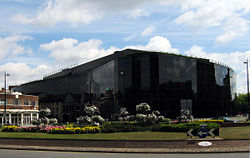
Like many other similar towns, Ipswich is home to many artists, with galleries at Christchurch Mansion, the Town Hall, a gallery in the Ancient House and the Artists Gallery in Electric House being the more prominent. The visual arts are further supported with many sites of sculpture with easy accessibility. The Borough Council promotes creation of new public works of art and has been known to make this a condition of planning permission.
The town houses Ipswich Museum and the Ipswich Transport Museum.
Performing arts are well represented with Ipswich being home to DanceEast which has the primary aim of advocating innovation and development of dance in the East of England. They are building new premises as part of the waterfront development. These will be the first custom built dance facilities in the East of England at a cost of around £8million.
The Eastern Angles theatre group are based at the Sir John Mills Theatre in Ipswich, named after the famous actor who lived in Felixstowe as a child.
Since 1991, there has been an annual arts festival called Ip-Art which brings together many events across art disciplines and different venues, notably a free music day in Christchurch Park, which in 2006 had over 50 different acts performing over 7 stages.
Norwich remains the regional centre for TV broadcasting, but both BBC East and Anglia TV have presenters and offices in Ipswich. The town has three local radio stations, BBC Radio Suffolk covering the entire county, where the East Anglian Accent can be heard on its many phone-ins, the commercial SGR-FM which was founded in 1975 as Radio Orwell covering the A14 corridor in Suffolk and Town 102 which was founded in 2006 and is the first full time commercial station specific for Ipswich. The younger audience is catered for with Suffolk based Kiss 105-108. On 15 August 2007, Ipswich Community Radio launched full-time after successfully gaining a licence in early 2006.
The town's daily evening newspaper is the Evening Star (Ipswich) which is the sister title to the county's daily morning newspaper the East Anglian Daily Times.
Buildings
In addition to Christchurch Mansion and the Ancient House, Ipswich in the 21st century has some important cultural buildings including the New Wolsey Theatre and the Regent Theatre - the largest theatre venue in East Anglia where in the 1960s The Beatles performed under its former name the Gaumont.
There are several medieval Ipswich churches but the grandest is the Victorian St Mary le Tower.
Modern buildings include the new Suffolk County Hall in the area known as Ipswich Village close to Ipswich Town's Portman Road stadium. The stadium has hosted England under 21, under 23 and full international matches in addition to an England hockey game.
On the north-west side of Ipswich lies Broomhill Pool, a Grade II listed Olympic-sized lido which opened in 1938 and closed in 2002, since which time a campaign to see it restored and re-opened has been run.
Industry
Industry around Ipswich has had a strong agricultural bias with Ransomes, Sims & Jefferies Ltd, one of the most famous agricultural manufacturers, located in the town. It is notable that the world's first commercial motorised lawnmower was built by Ransomes in 1902. There was a sugar beet factory at Ipswich for many years; it was closed in 2001 as part of a rationalisation by British Sugar.
The British Telecom Research Laboratories were located to the east of the town in 1975 at Martlesham Heath. They are now a science park called Adastral Park. The area was originally RAF Martlesham Heath - a WW2 airfield from where Douglas Bader fought.
Ipswich is one of the Haven ports and is still a working port, handling several million tonnes of cargo each year. Prior to decommissioning, HMS Grafton was a regular visitor to the port which as special links with the town and the county of Suffolk. HMS Orwell, named after the river, is also closely linked with the town. With the rise in popularity of the town around the Neptune Marina and the Wet Dock a number of ship and boatbuilders have become established, in particular Fairline Yachts are a significant employer.
Transport infrastructure
Road
The A12 links Ipswich to London (84 miles), Lowestoft, Great Yarmouth and the M25. The A14 links the town with Cambridge (57 miles), the Midlands and Felixstowe. The A140(single carriageway) links the town with Norwich.
A Roman road originally known as Pye Road and part of which is now the [A140], linked Colchester with Caistor St. Edmund near Norwich. An old milestone in Ipswich shows London as 69 miles (111 km) and Gt Yarmouth 54 miles (87 km) north.
Rail
Ipswich railway station is located on the Great Eastern Main Line from London Liverpool Street to Norwich. It is also the junction of railway lines to Felixstowe and Lowestoft. The station is served by National Express East Anglia. There is another railway station serving the Rose Hill area, called Derby Road which is on the line to Felixstowe.
Bus & tram
Bus services are operated by Ipswich Buses and First Eastern Counties. Route number 66 is a partially guided busway connecting Martlesham Heath and Kesgrave to the town and the railway station. It also had a trolleybus system from 2 September 1923 until 23 August 1963.
It is the last place in the area to have an independent bus company with the unusual practice of naming its buses.
Air
The town used to feature a small grass-runway airport ( ICAO code: EGSE), opened by His Royal Highness the Prince of Wales on 26 June 1930 with regular flights to Clacton, Southend and Jersey by Channel Airways and later to the Netherlands and Manchester by Suckling Airways. The airport was delicensed on 31 December 1996 Ipswich Airport and the area was re-developed into the residential district of Ravenswood with the front of the Grade 2 listed control building, designed by Heining and Chitty in 1938, integrated into new scheme.
The nearest international flights now are from Stansted Airport and Norwich International Airport, both approximately 47 miles (76 km) away. Other airports within a 2 hour drive are Gatwick and Luton Airport.
Port
The Port of Ipswich, operated by Associated British Ports offers a mix of facilities for handling containers, timber, dry bulk cargo oil as well as a Ro-Ro terminal. It is one of the Haven ports along with the Port of Felixstowe and Harwich International.
Sport
Ipswich's sole professional football team are Ipswich Town Football Club, who were established in 1878 and play at the 30,300 capacity Portman Road Stadium. They have a strong rivalry with Norwich City F.C.. Ipswich Town was home to the two most successful England managers, Sir Alf Ramsey (who is buried in the Old Cemetery in the town) and Sir Bobby Robson. They won the League Championship in 1962 during Ramsey's reign and an FA Cup in 1978 and the UEFA Cup in 1981 under Robson. They currently play in English football's second-tier league, the Football Championship. Ipswich is also home to minor-lower league football team, Ipswich Wanderers and many others in the Suffolk and Ipswich Football League.
Ipswich has a world class gymnastics centre which is expected to be used as a practice centre prior to the 2012 Olympics. The resident gymnastics club has also been home to international gymnasts.
Ipswich also has a very successful Speedway team, the Ipswich Witches, who have ridden at their Foxhall Stadium home, on the outskirts of Ipswich, for over 50 years. Despite being one of the most successful teams in British Speedway history, crowds have dwindled to around 1,500 people per race meeting. The stadium is also regularly used for Stock car racing.
The town has representation in both codes of Rugby. It has two amateur Rugby Union teams, Ipswich RUFC who play in London 3 North East League, and Ipswich YM RUFC and an amateur rugby league side, Ipswich Rhinos, who play in the Rugby League Conference.
Ipswich had a racecourse which ran a mix of flat and National Hunt races from 1710 to 1911.
For her services to swimming Karen Pickering was awarded an MBE in the 1994 New Years Honours List, although she is actually from Great Yarmouth.
Famous residents
Probably the most famous person born in the town is the Tudor Cardinal Thomas Wolsey. The artist Thomas Gainsborough and the cartoonist "Giles" worked here, Horatio, Lord Nelson became Steward of Ipswich, and Margaret Catchpole began her adventurous career here. Alf Ramsey and Bobby Robson were both successful managers of Ipswich Town F.C.
